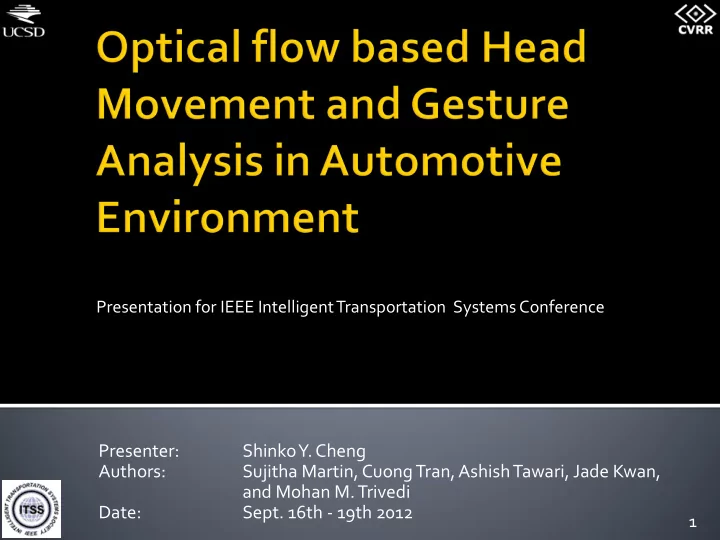

Presentation for IEEE Intelligent Transportation Systems Conference Presenter: Shinko Y. Cheng Authors: Sujitha Martin, Cuong Tran, Ashish Tawari, Jade Kwan, and Mohan M. Trivedi Date: Sept. 16th - 19th 2012 1
Introduction and Motivation Key Terms and Research Issues Related Studies Optical flow based Head Movement and Gesture Analyzer (OHMeGA) Concept and Algorithms Noise and Other Practical Matters Experimental Results Concluding Remarks 2
Head pose is the 3D orientation of a head. y (yaw) x (roll) (pitch) z 3
Head pose is the 3D orientation of a head. Head dynamics is the motion that describes the change in head position Head pose: Head pose: Head Dynamics: Pitch = 0° Pitch = 0° Pitch = 0° Yaw = -30° Yaw = +30° Yaw = +60° 4 Roll = 0° Roll = 0° Roll = 0°
Head pose is the 3D orientation of a head. Head dynamics is the motion that describes the change in head position Head gesture entails how the head moved from the starting orientation to the ending orientation. 5
Safety of the driver and those in the vicinity is highly dependent on the driver’s awareness of the constantly changing driving environment Head gesture detection and analysis is a vital part of looking inside a vehicle when designing intelligent driver assistance systems (IDAS). 6
7
Continuous head pose estimation for head gesture analysis is computationally intensive. Higher level cues Fixation time and location Rate of motion and rate of change in motion System goals for head gesture analysis in IDAS Runs in real-time User-independent Simple to implement and set-up Robust and accurate 8
Feature vectors like head motion histograms (from head pose) for lane change intent prediction [1]. Head nodding frequency using head pose to determine driver vigilance[2]. Foot gesture analysis using optical flow in prediction of driver behavior [3]. [1] B. Morris, A. Doshi and M. M. Trivedi , “Lane Change Intent Prediction for Driver Assistance: Design and On- Road Evaluation,” IEEE Intelligent Vehicles Symposium, 2011. [2] L. M. Bergasa, J. Nuevo, M.A. Sotelo, R. Barea , and M.E. Lopez, “Real – time system for monitoring driver vigilance,” Intelligent Transportation Systems, IEEE Transactions on, 7(1):63-77, march 2006. [3] C. Tran, A. Doshi, and M.M. Trivedi , “ Modelling and Prediction of Driver Behavior by Foot Gesture Analysis”, Computer Vision and Image Understanding, 2012. 9
• Intuitiveness: head gestures can be segmented into head motion states and no-head motion (fixation) states. • Higher level cues: rate of head motion, rate of change in head motion, and fixation time. 10
Rule based state machine Two types of states Dynamic (motion) Static (no-motion or fixation) Two parts Horizontal motion Vertical motion Each set of colored arrows represent the flow of one of four unique head gestures. 11
• From a frontal facing camera, head motion in yaw and pitch rotation angle can be represented as motion in the vertical and horizontal direction of the 2D image plane. • Steps to compute global flow vector: • Interest point detection • Lucas- Kanade’s optical flow algorithm • u = -S -1 d • • Majority vote on optical flow vectors 12
Non-ideal conditions are: Finite frame rate Noise in the camera sensors (i.e. camera vibrations) Motions detected by optical flow in the image plane may not be only due to head movements (i.e. hand movements near the face) No-direct correspondence between head rotation in yaw (pitch) angle to horizontal (vertical) motion in the image plane 13
Prequal Exam OHMEGA in the Context of Driving 9/5/2012 Head gesture: FxS ML FxL MR FxS Top curve: horizontal motion detected in the image plane with state labels Bottom curve: ground truth state labels Using threshold and area under the curve to handle noise 14
OHMeGA is evaluated on two sets of data In-laboratory: ▪ 5 subjects (~600 head gestures), ▪ Subjects followed instructions (i.e. “STOP” and “GO”) by pressing the brake or the accelerator pedal ▪ Subjects answered “distractions” in the form of mathematical equations on the right side monitor. On-road: manually selected head gestures for preliminary evaluations 15
• FxS • ML • FxL • MR Global flow Motion in the x- vector with direction of the labels image plane Ground truth labels Frame 16
FxS FxR FxL FxD FxS 0.943 0 0 0 FxR 0 0.76 0 0 FxL 0 0 0.833 0 FxD 0 0 0 0.806 Samples 926 25 60 31 MR ML MD MU MR 0.8 0 0 0 Figure: Data collected using frontal facing camera from ML 0 0.917 0 0 on-road experiment is processed first using optical flow to obtain head motions, then annotated using OHMeGA MD 0 0 0.913 0 analyzer and finally separated into three types of MU 0 0 0 0.907 gestures. Samples 145 120 69 86 18
OHMeGA is user-independent, simple to implement and set up, and runs in real- time This implementation of OHMeGA relies only on head dynamics. OHMeGA can derive higher level cues such as fixation time and relative rate of motion 19
Represent 3D head motion in the yaw and pitch rotation angle with both horizontal and vertical motions in the 2D image plane Optimize global flow vector calculation for out of plane rotations (currently optimal for in plane movements). 20
Colleagues in Laboratory for Intelligent and Safe Automobiles, UC San Diego 21
Any Questions? 22
Recommend
More recommend